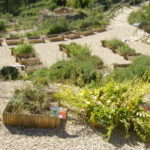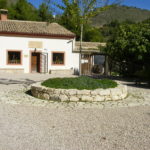Biologic Station Torretes-Font Roja, Botanic Garden, Alicante, Spain
- NAME Estación Biológica Torretes-Jardín Botánico
- ADDRESS IBI, Alicante
- WEBSITE https://web.ua.es/jardinbotanico/
- EMAIL MEDIOAMBIENTE@IBI.ES/ESTACION.TORRETES@UA.ES
- PHONE (+34) 96 655 31 68.
- OPENING HOURS The opening hours are from 9.00 to 14.00 from Monday to Friday. To arrange other timetables or guided visites for groups, please contact the technicians the station through the electronic adresses shown in the website. To arrange visits you can contact with: museobiodiversidad@ibi.es or in the phone (+34) 96 655 31 68.
- OWNERSHIP Public
- DIRECTOR Segundo Ríos Ruiz
- FACILITIES (Español) Laboratorios, invernaderos, maquinaria agrícola, caldera-destilador de aromáticas, Banco de germoplasma
- AREA (IN SQM) 10 Ha
- NUMBER OF SPECIES >100
- COLLECTIONS Two kind of collections: generals and monographic General Medicinal plant collection: medicinal plants, food and industrial plants among others. Monographics Salvietum: more than 100 species from all the continents (except Australia) Narcissus: species from the Iberian Peninsula, North of Africa, and other Mediterranean places. There is also a rose garden where it has been compiled old roses collection and wild roses Houseleek collections: (Sempervivum sp.pl) and carnations Collections functions: To be attractive for the visitors, to contribute to the conservation of endemic species in danger of extinction and to be a platform for research projects in course or future projects, to look for processes of active ingredients for the food, pharmaceutical or cosmetic industry.
- CONSERVATION PROGRAMMES Around 10 Ha of the Station are a part of the Natural Park of Carrascal de la Font Roja. The regional Government has recognized the Flora and Fauna of the area with different categories of protection: Microreserve of Flora Mas Torretes (more info in pdf and map), Declaration of Voluntary Fauna Reserve which provide the Biological Station with outstanding environmental conditions. The main species with high priority are Gypsophylla pilosa, Linaria repens subsp. blanca, la Papaver somniferum subsp. Setigerum but there is almost 1000 plants in the area. The Biological station works actively in land conservation and responsible use of the water.
- RESEARCH PROGRAMMES Ethnobotanic: conservation of natural ressources and seeking new products to contribute to local development. Search of bio-products for the industry working with the medicinal plants. Plants multiplication and conservation: to develop routines of massive multiplication which are essential for conservation of vulnerable and endangered species as well as to develop new sustainable crops. Vegetal restoration of riversides and other wet ecosystems through the flora and vegetal communities knowledge.
- EDUCATION PROGRAMMES Link between Science and Society through the Culture of plants and animals. It exists a Biodiversity Museum where dissemination activities are carried out and reviews are published, organizing events related with the mycology science.
 The Biological Station of Torretes was established in 2006 as a research, conservation and education center of the Mediterranean Biodiversity, depending on the CIBIO (University Institute of Research). In 2012, the Botanic Garden of the Torretes Biological Station has been created as a part it.
The Biological Station of Torretes was established in 2006 as a research, conservation and education center of the Mediterranean Biodiversity, depending on the CIBIO (University Institute of Research). In 2012, the Botanic Garden of the Torretes Biological Station has been created as a part it.
The Biological Station of Torretes was established in 2006 as a research, conservation and education center of the Mediterranean Biodiversity, depending on the CIBIO (University Institute of Research). In 2012, the Botanic Garden of the Torretes Biological Station has been created as a part of it.
 The main objectives of the station are:
The main objectives of the station are:
• Conservation of Mediterranean Flora
• Surveying, research, development and innovation
• Scientific knowledge transfer to society
• Land Stewardship and contribution to rural and local development
 In order to make the Botanic Garden more attractive, different structures, pathways, agricultural plot with botanical and ethnobotanic al interest aimed to conservation of plants and traditional natural resources of the Mediterranean Culture have been implemented. Moreover, medieval gardens with medicinal plants are integrated in the landscape and architectonic elements such as fountains are planned to be installed.
In order to make the Botanic Garden more attractive, different structures, pathways, agricultural plot with botanical and ethnobotanic al interest aimed to conservation of plants and traditional natural resources of the Mediterranean Culture have been implemented. Moreover, medieval gardens with medicinal plants are integrated in the landscape and architectonic elements such as fountains are planned to be installed.
